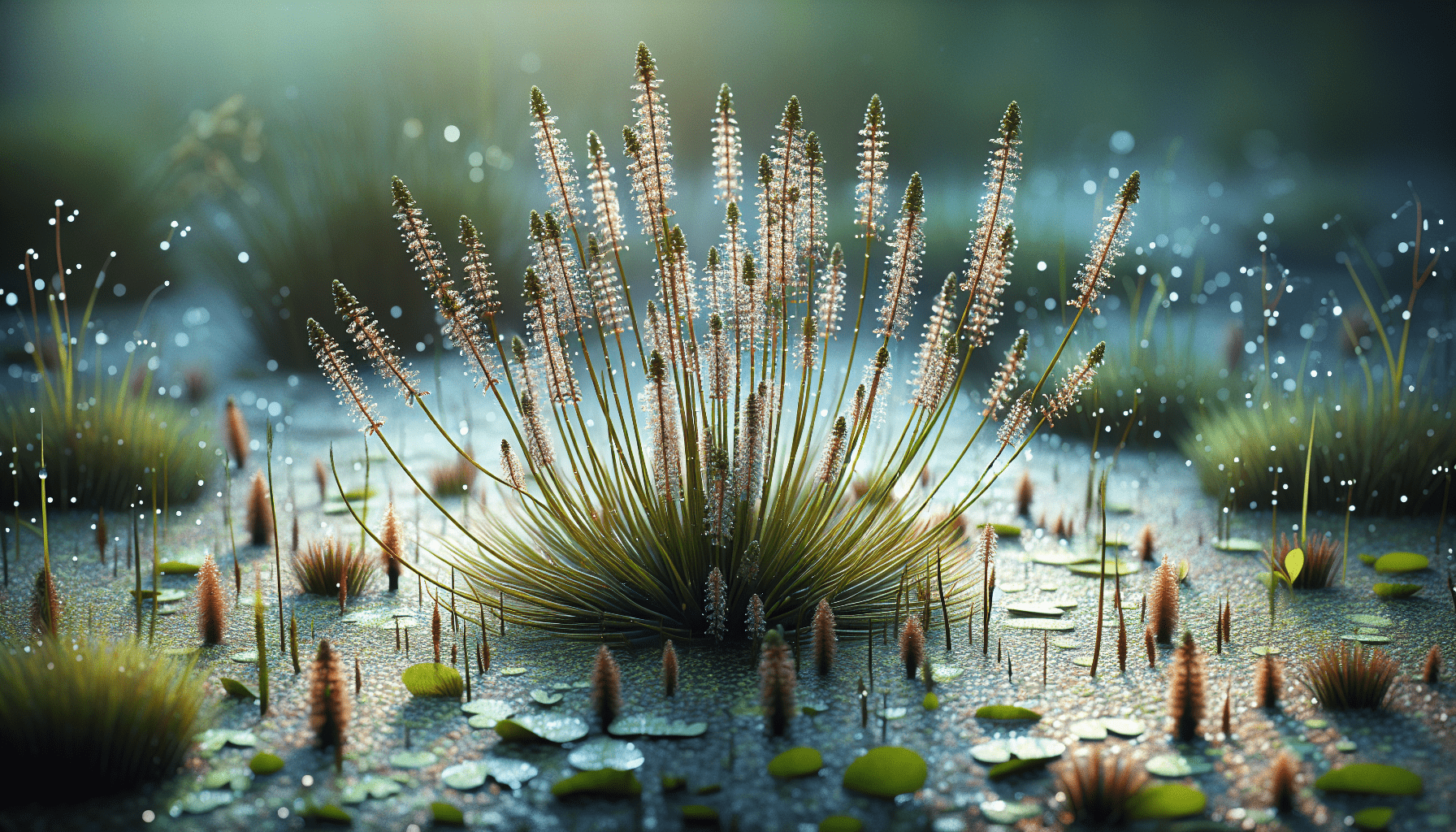In the intricate world of aquatic plant life, the name Eleocharis macrostachya may not immediately conjure familiar images. Also known as the pale spikerush or creeping spikerush, this plant is a member of the Cyperaceae family and thrives in moist to wet habitats. Your comprehension of aquatic weeds is set to expand as the following sections illuminate critical aspects surrounding this plant such as its biological structure, habitat preference, and ecological impact.

Definition of Eleocharis Macrostachya
Eleocharis macrostachya, commonly known as pale spikerush or common spikerush, is a species of flowering plant in the sedge family. It is a perennial aquatic plant that is native to many regions of North and South America. Known for its slender, grass-like stems and spiky seed heads, this plant generally thrives in wet environments such as marshes, bogs, and along the banks of streams and lakes.
Characteristics of Eleocharis Macrostachya
The first distinctive trait you recognize regarding Eleocharis macrostachya is its above-ground morphology, which typically exhibits green, slender, round and hollow stems that can extend up to about 80cm tall. Each stem is topped by a solitary long spikelet that bears several small, yellowish-brown flowers during bloom. The plant does not have leaves but it has sheaths that grow at the bottom of the stem.
Walking through the Taxonomy of Eleocharis Macrostachya
Diving deeper into its taxonomy, Eleocharis macrostachya belongs to the kingdom Plantae and falls under the class of monocotyledons, which are characterized by seeds with one embryonic leaf. As a part of the family Cyperaceae, it shares familial ties with over 5,000 species of sedges, but its distinct characteristics separate it into its own tribe, Eleocharideae. It is classified under the genus Eleocharis, a group of plants known for their aquatic or semi-aquatic habitat preference.
Regional Distribution of Eleocharis Macrostachya
As mentioned earlier, the geographical distribution of Eleocharis macrostachya is quite extensive, spanning across North and South America. It is native to regions as far south as Argentina and Chile and can be found northward into the United States and Canada.
Eleocharis Macrostachya as an Aquatic Weed
Despite its broad distribution, Eleocharis macrostachya is not always a welcome inhabitant. Its rapid growth and extensive rhizome system often lead to its categorization as an aquatic weed.
How Eleocharis Macrostachya Becomes an Invasive Plant
The aggressive nature of Eleocharis macrostachya becomes evident when this plant overtakes native vegetation due to its excellent adaptability to various conditions, swift growth rate, and aptitude for colonizing new environments. The plant’s ability to grow in dense stands with a high level of competition potential further adds to its invasive characteristics.
The Impact of Eleocharis Macrostachya on Aquatic Environments
When it comes to the impact on aquatic environments, the detrimental effects of an Eleocharis macrostachya infestation are manifold. It has the potential to significantly alter the aquatic ecosystem structure by outcompeting native aquatic plants and creating a monoculture that inhibits biodiversity. Its dense growth can also obstruct water channels and consequently disrupt water flow, which can negatively impact local hydrology and wildlife.
Examples of Ecosystems Affected by Eleocharis Macrostachya
Specific ecosystems significantly affected by the Eleocharis macrostachya infestation include wetlands, streams, rivers, and lake edges. These areas often bear the brunt of this aggressive invasion, seeing a reduction in native vegetation, changes in water clarity, and potential disruption to aquatic wildlife.
Growth Behavior of Eleocharis Macrostachya
Understanding the growth behavior of Eleocharis macrostachya is critical in predicting and managing its spread.
Nutrient Requirements of Eleocharis Macrostachya
This plant does not require a high level of nutrients to survive and can even thrive in nutrient-poor soils. The key to its survival lies in its ability to store nourishment in its rhizomes, which it can rely on during lean periods.
The Ideal Growing Conditions for Eleocharis Macrostachya
Eleocharis macrostachya demonstrates a wide tolerance range when it comes to environmental conditions. It can thrive in full sun conditions, but is also able to tolerate partial shade. Furthermore, it can survive in a broad range of pH levels and water depths, making it very versatile.
Stages of Eleocharis Macrostachya Plant Growth
The growth of Eleocharis macrostachya can be characterized by different stages. Initially, it emerges as a clump of thin stems from its rhizome system. Following this, the plant’s spikelets start to develop and eventually give way to flowers. As the plant matures, these flowers will produce seeds that continue the plant’s life cycle.

Reproduction and Spread of Eleocharis Macrostachya
In terms of reproduction, Eleocharis macrostachya leverages both sexual and asexual strategies, thus ensuring its proliferation.
Dispersion Methods Used by Eleocharis Macrostachya
Its seeds, which can number into the thousands per plant, are dispersed by water and wildlife. Meanwhile, its extensive, rhizomatous root system enables it to spread vegetatively, contributing significantly to its invasive ability.
The Role of Seed Germination in the Spread of Eleocharis Macrostachya
Seed germination plays a significant role in the establishment and spread of Eleocharis macrostachya. The seeds, with their hardy coat, can remain dormant for extended periods until conditions are optimal for germination. The seed’s resilience allows it to persist in the environment and aids the species’ propagation.
How the Plant Propagates in Different Habitats
In addition to its ability to spread via seeds and rhizomes, Eleocharis macrostachya has the advantage of being a highly adaptable species. It is capable of propagating in a wide range of habitats, only requiring the presence of water for successful establishment. This ability to colonize varied habitats enhances its spread and invasion potential.
Identification of Eleocharis Macrostachya
Despite extensive variations in plant forms within the Eleocharis genus, careful observation of certain characteristics can help in correct identification of Eleocharis macrostachya.
Physical Characteristics for Identification
The plant can be identified by its solitary spikelets, leafless, erect stems, and its preference for wet, marshy environments. In addition, the tubers formed along the rhizomes are an important distinguishing trait of this plant.
Similar Species and Common Misidentifications
Several similar species can be mistaken for Eleocharis macrostachya such as Eleocharis baldwinii and Eleocharis acicularis. Misidentification can lead to imperfect management strategies or ineffective control methods if the characteristics of the concerned species are unalike.
Field Identification Tips
When attempting field identification, it is useful to note the plant’s physical attributes, its habitat, and the presence of certain distinctive features such as the tubers or sheaths, which can aid in accurate identification.
Control and Management of Eleocharis Macrostachya
Although control and management of Eleocharis macrostachya can be challenging due to its resilient nature, there are various physical, chemical, and biological measures that can be employed.
Physical Control Measures
Manual or mechanical removal is a common physical control measure. This involves clearing infested areas and uprooting the plants, ensuring to leave no rhizomes behind as they can foster regrowth.
Chemical Control Measures
Chemical measures usually involve the use of herbicides. However, the application of such substances should be done with caution, ensuring enough knowledge exists to minimize non-target effects and potential environmental impact.
Biological Control Measures
Biological control methods involve using natural enemies or competitors of the weed for control. However, this method often requires thorough research and time to ensure the biocontrol agent would not itself become an invasive species.
Case Studies of Eleocharis Macrostachya Management
Despite the challenges involved, some management methods have proven successful in controlling Eleocharis macrostachya.
Successful Management Strategies
Success has been achieved through integrated management strategies that combine physical, chemical, and biological methods. These strategies often involve regular monitoring and timely intervention to prevent severe infestations.
Challenges Encountered in Management
One of the main challenges is the weed’s ability to rapidly establish and spread, coupled with its tolerance to a range of environmental conditions. Deferred detection and lack of awareness can also hurdle effective management.
Lessons Learned from Past Efforts
The body of research and case studies on Eleocharis macrostachya management provides valuable insights. Among lessons learned is the importance of early detection and speedy intervention to prevent the plant from establishing a sizeable presence, which then becomes a lot tougher to control.
Ecological Impact of Eleocharis Macrostachya
Eleocharis macrostachya’s invasive capacities pose a serious threat to local ecosystems, and its effects are multifold.
Effects on Local Biodiversity
By outcompeting native vegetation, Eleocharis macrostachya disrupts habitats and food resources for local wildlife, therefore upsetting biodiversity. It has the potential to transform diverse aquatic ecosystems into monospecific stands of spikerush.
Impact on Aquatic and Terrestrial Wildlife
Wildlife can be directly and indirectly affected by Eleocharis macrostachya. Besides altering the available plant diversity, the weed’s dense growth can also inhibit movements of aquatic species and potentially modify the natural dynamics of predator-prey relationships.
Consequences for Human Use of Affected Areas
Human activities such as fishing, boating, or simply enjoying the natural scenery can be hindered by the uncontrolled spread of Eleocharis macrostachya. Prolific growth in waterways can obstruct access, turning recreational areas unattractive and in some cases, unusable.
Economic Implication of Eleocharis Macrostachya Infestation
Beyond its ecological impact, the spread of Eleocharis macrostachya also incurs significant economic costs.
Costs Associated with Control and Management
From initial detection to containment and removal, managing Eleocharis macrostachya infestations can be quite costly. Furthermore, the need for continuous monitoring and repeated treatments to ensure no resurgence occurs adds to the overall financial burden.
Impact on Commercial Fishing and Aquaculture
Commercial operations such as fishing and aquaculture may also bear the economic brunt of Eleocharis macrostachya infestations, as the plant’s dense growth can impede access, increase maintenance costs, and possibly disrupt the natural aquatic food chain.
Effect on Property Values in Infested Areas
The aesthetic degradation of infested water bodies can potentially lead to a decrease in property values around these areas. This can have ripple effects on local economies, particularly those heavily reliant on tourism.
Future Outlook on Eleocharis Macrostachya
Looking ahead, there are several factors that may influence the future spread and impact of Eleocharis macrostachya.
Predicted Spread and Impact
Projections suggest an increased potential for Eleocharis macrostachya to invade new territories, especially in the face of climate change and linked shifts in weather patterns. More research, however, is needed to precisely understand the variety of impacts this would have on different ecosystems.
Emerging Control Techniques
Advancements in management techniques offer promise for more effective control, including the development of more targeted and environmentally friendly herbicides, as well as innovative biocontrol measures.
The Role of Climate Change in Future Infestations
Climate change, with its impacts on temperature and precipitation patterns, can create more favorable conditions for Eleocharis macrostachya to establish and spread, thereby presenting additional challenges for management efforts.
In conclusion, Eleocharis macrostachya is more than just a water-dwelling plant–it is a potential ecological disruptor with far-reaching impacts. Accordingly, understanding its biology, monitoring its spread and developing effective management strategies are critical endeavors for scientists, land managers, and policymakers alike.